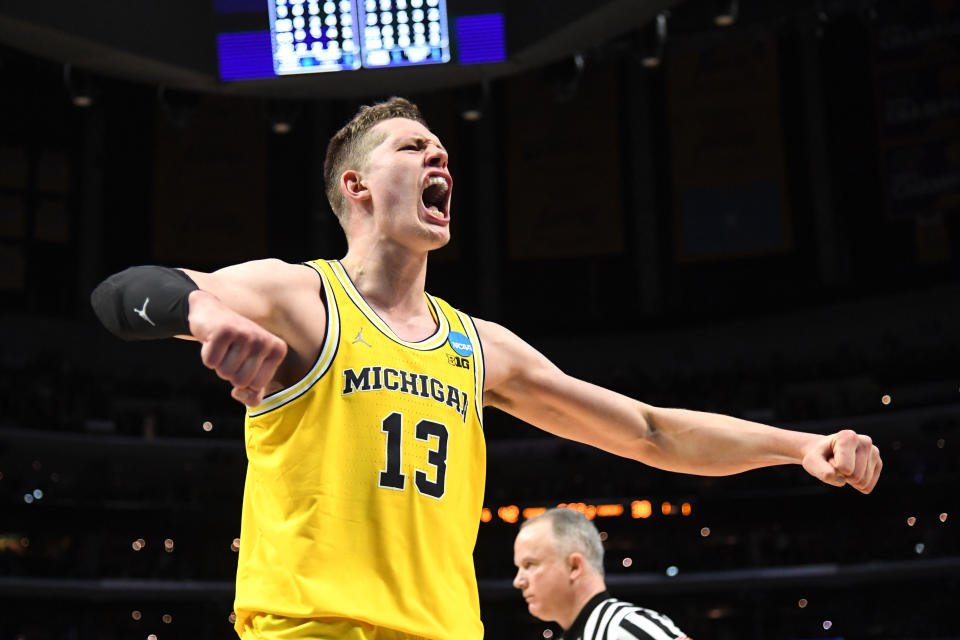Final Four preview: How Michigan vs. Loyola will be decided at both ends of the court
A week of anticipation is almost over. The Final Four is almost here. The first of two games pits 11th-seeded Loyola Chicago against third-seeded Michigan (Saturday, 6:09 p.m. ET, TBS). With less than 48 hours to go until tip-off, here’s a look at the matchup and the factors that will decide it.
Call them a Cinderella. Call them a surprise. Maybe even call them a bit fortunate – just like their Final Four opponent on Saturday, and just like most teams that win four consecutive games in the NCAA tournament. But whatever you do, don’t call the Loyola Chicago Ramblers a fluke.
They are an 11-seed, but they have proven over the past two weeks that they belong – not just in the NCAA tournament; deep in it. They are a legitimate major-conference title threat masquerading as a mid-major. They stunned Miami, toppled Tennessee, nipped Nevada and blew out Kansas State.
In San Antonio, though, they’ll meet their toughest opponent yet. It’s the first of the five that ranks among Ken Pomeroy’s top 10. It’s also a team seemingly equipped to neutralize one of Loyola’s strengths, and exploit one of Cinderella’s main weaknesses. Let’s dive in.

WHEN LOYOLA HAS THE BALL: Strength vs. strength
Two numbers sum up the offensive attack that has led Loyola to the Final Four: 13 and 65.4.
Let’s start with the latter. It’s Loyola’s assist percentage during the NCAA tournament. Projected out over a full season, it would have ranked second in the nation. It’s emblematic of a systematically selfless offense and individually selfless players who embody the cliché, “more than the sum of their parts.” Their spacing is excellent, their ball-movement crisp and constant, and their cuts precise.
As a team, Loyola shoots over 40 percent from 3, and at any given time will have at least four capable long-range marksmen on the floor. That’s certainly an important facet of its attack. But it actually doesn’t take too many 3s. Instead, it uses the threat of the 3 to punish over-aggressive defenses around the rim.
Which leads us to our second number, 13. That’s how many 2-pointers Loyola has attempted outside of the paint over the past four games combined. It’s an astonishingly low number, and it shows how effective the Missouri Valley champs have been getting to the rim despite being at a size disadvantage in three of their four tourney games.
On Saturday, though, the Ramblers will meet their match. They’ll meet a team that keeps opponents out of the paint and runs them off the 3-point line better than any other Division I club. Per hoop-math.com, 43.3 percent of the shots taken by Michigan’s adversaries this season have been 2-point jumpers. That’s tops in the nation by almost two full percentage points.
It’s also a reason why the Wolverines have been so good in general on this end of the floor. Aided by a former high school history teacher who John Beilein hand-picked to be his “defensive coordinator,” Michigan has risen to No. 4 nationally in adjusted defensive efficiency. Luke Yaklich, that assistant coach, will have Loyola scouted, and his players will be prepared to disrupt the Ramblers’ offensive flow. If they can, Michigan will have the upper hand.
WHEN MICHIGAN HAS THE BALL: Loyola’s Mo Wagner problem
Whereas Loyola’s offense is fueled by balance and fluidity, there’s a single matchup at the other end of the floor that could go a long way toward determining how the game plays out. It’s Mo Wagner versus Cameron Krutwig. Or maybe it’s Mo Wagner vs. somebody else.
Wagner is a special talent and a matchup nightmare. He’s not just a stretch-five. He’s a mobile five who can take you out to the 3-point line, then blow by you on his way to the rim if your close-out is sloppy or your athleticism isn’t up to par. Or, if you go small to contain him, he’ll do his work down low.
He’s a problem for Loyola because Krutwig, a 6-foot-9 freshman – coach Porter Moser’s only option above 6-foot-6 – isn’t exactly the fleetest of foot. A skilled passer and below-the-rim finisher, he is an important asset for the Ramblers on offense. But he became such a defensive liability against Nevada’s five-guard/wing lineups that Moser scrapped the gameplan mid-stream and went to a five-guard/wing lineup of his own. He gave Krutwig just 13 minutes – the big man’s fewest of the season – and rode a 6-foot-5 center to a narrow victory.
Wagner could have a similar effect. His presence allowed Michigan to ravage a Texas A&M team with two true bigs, and forced Florida State to limit its 7-foot-4 center, Christ Koumadje, to just seven minutes.
Florida State, though, had a bevy of 6-foot-8 forwards who could bang with Wagner and chase him around. Loyola doesn’t exactly have that. Donte Ingram or Aundre Jackson would draw the assignment if Krutwig sits. They weren’t exposed by Nevada, whose tallest player was 6-foot-7. Wagner is 6-foot-11, and could do what the Wolf Pack couldn’t.
And in what will likely be a methodical, low-scoring game, the possessions that Wagner wins for Michigan – either by beating a smaller or slower opponent, or by drawing doubles and thus creating open shots – could be the difference.
– – – – – – –
Henry Bushnell covers soccer and basketball for Yahoo Sports. Have a tip? Question? Comment? Email him at henrydbushnell@gmail.com or follow him on Twitter @HenryBushnell.



